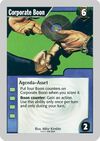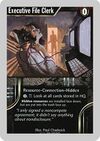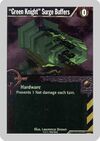Netrunner

So you want to play one of the most interesting and unique trading card games that ever saw the light? Well, you certainly found the right page! 1996 was the year Richard Garfield and Wizards of the Coast brought us Netrunner, a trading card game for two players. The most interesting part about it is probably that it's an asymmetric game, meaning that both player fulfill a different role within the match. One player will be the Runner and the other player will incarnate the Corp. The game is long since inactive and WotC has stopped printing cards for it.
 This page is needs images. Help plz. This page is needs images. Help plz. |
Goal of the Game
In the near future everything is digitalized. Big corporations rule the world and guide the people through their life. Or maybe they oppress the population into doing their shady business. No one knows for sure. But the Runners, internet jockeys that use their brain as a computer are all about unveiling the truth. The corporations don't take lightly on this behaviour and try to wring these data-terrorists out of exsitence.
The game is won by collecting agenda-points or lost by matching a few conditions. Agendas are projects the corp works on and each has a value displayed in the lower right corner of the card. The Corp has to install agendas and advance on them until the conditions on the card are met. It then scores the agenda, sets it aside and has as many points as depicted on the card. The Runner has to uncover/steal the agendas from the corp. You can make runs on everything the Corp has: Their hand (aka HQ), their deck (aka R&D), their discard pile (aka Archives) or data forts. When a runner finds an agenda somewhere he just scores it and scores the points on depicted on the card. Effects on the cards generaly don't affect the runner.
Whoever amasses 7 points or more in a game, wins.
Ways to lose
You can however also lose the game, in which case your opponent wins by default. The Corp can run out of cards to draw from R&D. If you are forced to draw a card from R&D, but can't because the stack is empty, you lose. The Runner has to look out to not get his brain fried. If the runner sustains enough brain damage to reduce his maximum hand size from 5 to 0 he is braindead and loses the game. If he has at any point no cards in his hand an is forced to play or discard one he is flatlined and loses the game.
Match Preparations
For a full game you will need at least one Runner deck and one Corporate deck. Those decks can contain up to 60 cards each. While the Runner can assemble his Deck any way he likes the Corp has to have a specific amount of agenda cards, the bigger their deck is. More on that later Also get a ton of tokens. 40 tokens for both player are generally enough. Also, some cards may need a die so set one aside. You'll need table space for each player to have about a dozen cards, maybe a little more.
How to Play
Beginning of the Game
Now this shit gets interesting. Decide who plays their Corp deck and who plays their Runner deck. Shuffle each deck and draw 5 cards each. Five is also the maximum hand size for both players. Both players also get 5 Bits, which represent the currency in this game, but more on that later. Each player's turn is measured in Actions. Both players get 4 Actions, but the Corp must always use their first action to draw a card. Corp always gets the first turn.
What "Actions" can be used for
When it's your turn you can spend your four Actions however you want (except for Corp's first action, which is forced to be "Draw a card"). The options are as follows:
Both players use an action to:
- Draw a Card: take a card from their face-down deck and add it to their hand.
- Get a Bit: add a token to a pool in front of the player, used to represent money or liquid assets. Each bit of money for the Corporate player is obviously orders of magnitude larger than Hacker bits, but Corporations need to move oil-tankers and fund rock stars, while the Hacker can live on ramen and coffee.
The Corporate player may use an action to:
- Install an Agenda or Node in a subsidiary Datafort: Start a new pile in front of the player by placing an agenda card face-down on the table. Leaving an sole Agenda in a Datafort is ill-advised.
- Install an ICE on a Datafort: Add an ICE card face-down and "tapped" to one of the Datafort piles on the table. ICE can only be placed on top of a Datafort, never in the middle. Runners always encounter ICE from top-to-bottom, so the Agenda is always last. The first ICE on a Datafort comes at no cost to install. For another ICE on a Datafort that already has one you have to pay a Bit. The next one costs 2 Bits and so on.
- Install Upgrades: Upgrades are put face-down behind a Datafort and generally support something inside the Datafort when rezzed. There are also Regions which are Upgrades that have to be rezzed as soon as they are installed. An Upgrade is accessed by a runner when he reaches the last part of a Datafort, for example an Agenda.
- Do Operations: Operation cards are non permanent cards. Play them, follow their effect, store them in the archives.
- Advance a project: Agendas, some Nodes and even some Upgrades can be advanced. For each advancement you use an Action, pay a bit and put a token on the card in question. If the card is face down and the cards says nothing about revealing it upon advancement it stays face down.
- Make the Runner pay for keeping Tags: Tags, if we can give them to the Runner, are good for us. We can taken an action, pay 2 Bits and trash one of the Runners Resources at will if he has one.
The Runner may use an action to:
- Make a run on the Corp: explained later.
- Install Cards: If you have any programs, hardware or resources in your hand you can install these by paying their cost in bits and setting them down in front of you face up (or face down if it's something hidden).
- Use Preparations: Preparation cards are non permanent cards. Play them, follow their effect, put them in your trashpile.
- Lose a Tag: Tags are trouble! If you have one a desperate Corp can steer you into a world of hurt. For an Action and 2 Bits you can lose a Tag.
Keeping track of the play-area
We already told you this is an asymmetric game. That means that both players fulfill different roles during play. Their playfields also differ greatly. While the Runner lays nearly everything open in front of him, the Corp initially sets down everything face down. Look at the pictures on the right. I photographed two simple setups that show a bit of both playfields. Looks quite complicated eh? Well it's not, fuck you.
Below are each player's layouts with explanations.
Runner side
Corp side
A normal game of Netrunner
In this part I will lay out an example game of Netrunner for you to follow.
The Corp and the Runner both have a deck of 60 cards. After shuffling they draw 5 starting cards and take 5 Bits from their Bit pool. Corp always gets first turn.
| 1. Turn Corp | Our first goal should be to secure our vulnerable assets, as in our HQ and our R&D to prevent easy access for the runner. The best would be a cheap ICE-Code Gate or ICE-Wall. Let's see what we have in our starting HQ.
OK we got a few ICE, but both Sentries. Though they are good, especially in the beginning, they are also very expensive to rez. But maybe we are getting cheaper ICE-Code Gate or an ICE-Wall. So we use our first Action to draw from R&D like we are obligated to every turn. We Draw:
Great, just what we needed, a cheap ICE-Code Gate. We use our second Action to install the Quandary in front of our HQ. To do so, we set the Quandary card face down, a bit to the left of us and declare that this is the collumn that protects our HQ. We use our third Action to play Efficiency Experts to get 3 Bits without paying any. We show it to the Runner and then it is stored in our Archives, face down next to our R&D. Our fourth and last Action is used to install Ice Pick Willie in front of our R&D. Though it would be painful to rez it now, it will hopefully scare away the Runner for a bit. Our turn is now over, the Runners turn begins. | ||||||
| 1. Turn Runner | Ok, Corpboy got pretty defensive, but that is just the usual. I think I should get in some early runs, just for some tension.
My starting hand consists off:
Alright, alright. This got potential. Luckily I'm not bound to draw a card with my first action, so I have a bit more room to play on my turn. Let's think of the future and play Rigged Investments with my first Action. I have to pay 4 Bits for it, but it will provide me with more in the future, so it's a good investment. I don't even need actions to get more Bits out of it. So I lay it face up in front of me in my Resources Row, put 12 Bits from the pool on it and wait for the beginning of the next turn. Hmm... I guess I should scrap the idea of early runs with just a wall breaker and no Bits to spend but one. So let's get a bit of support up right now. For my second Action I play Dermatech Bodyplating, costing me 0 Bits and netting me protection from real life dangers, usually brought to me in meat damage. I put the card face up in my Hardware Row. My third Action will be playing my Green Knight Surge Buffers, laying it face up in my Hardware Row. It will protect me from any hazards of the web, trying to fry my brain. And last but not least I use my fourth and final Action this turn to play Executive File Clerk. I put it face down in my Resources Row. There are only hidden Resources in the game so I don't need a seperate "Hidden Row" for hidden Cards. I will only reveal this card to the Corp when I finally use it or the Corp is allowed somehow to see it. My turn is now over. I still have the Hammer card in my Hand and 1 Bit in my pockets. Next turn, there will be some runnin' to do! |
Will be continued - --Kajotex 18:18, 3 February 2012 (UTC)











